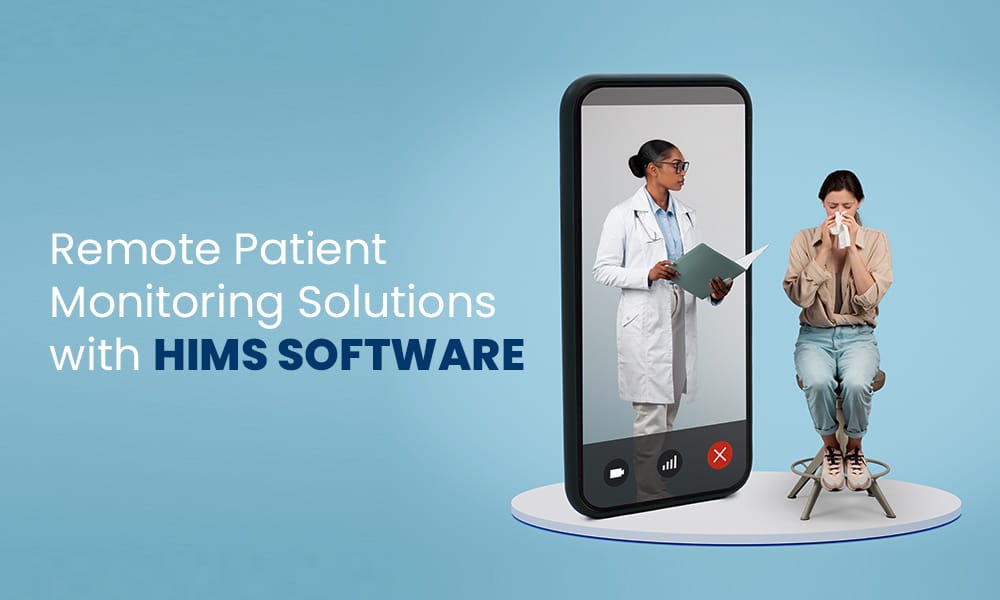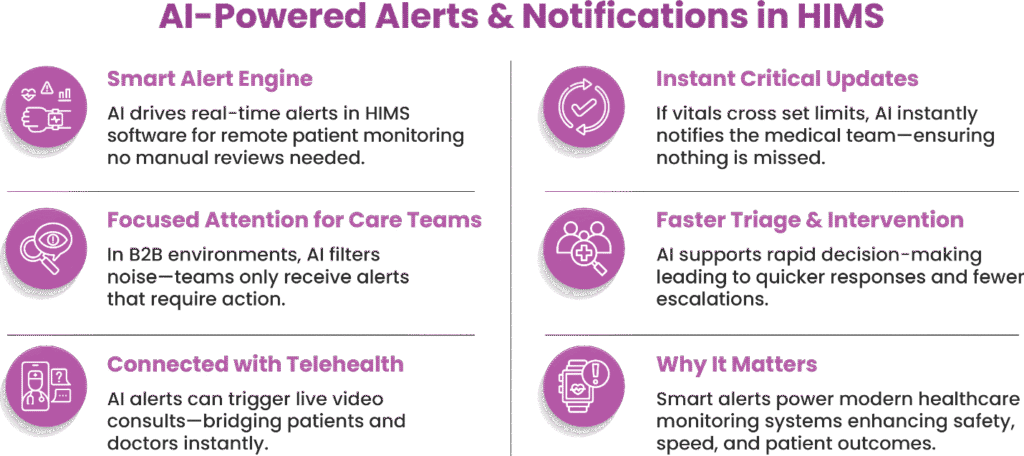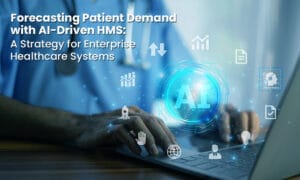
Remote patient monitoring is transforming healthcare delivery for modern hospitals and clinics. With real-time data, proactive care, and enhanced decision-making, healthcare providers now rely on integrated systems like HIMS software to streamline operations. In the B2B healthcare environment, the combination of remote patient monitoring with HIMS software creates a scalable, compliant, and efficient care model.
Healthcare institutions face growing challenges in managing patient care outside hospital walls. Remote patient monitoring addresses these issues by allowing providers to track vital signs, health conditions, and medication adherence. The value becomes exponential when these capabilities are part of a robust HIMS software. For any B2B healthcare service provider, HIMS software for remote patient monitoring is no longer optional; it’s a necessity.
Understanding Remote Patient Monitoring in the B2B Context
Remote patient monitoring enables healthcare providers to track patient data in real-time without physical visits. This data includes heart rate, oxygen levels, blood pressure, glucose levels, and more. In a B2B healthcare environment, remote patient monitoring translates to reduced hospital admissions, improved outcomes, and optimised resource utilisation.
When integrated with HIMS software, remote patient monitoring extends provider capabilities across inpatient, outpatient, and home care environments. Remote patient monitoring with HIMS software empowers institutions to centralise records, send alerts, and act immediately on abnormal health indicators.
The Role of HIMS Software in Modern Healthcare Operations
HIMS software stands at the core of modern healthcare monitoring systems. It provides unified access to patient records, lab reports, treatment plans, billing, and scheduling. When B2B clients evaluate technology vendors, the best HIMS software for RPM is one that unifies these elements with remote monitoring tools seamlessly.
Telehealth software adds another layer to the ecosystem. It facilitates consultations, prescriptions, and follow-ups digitally. However, without integration into HIMS software, telehealth becomes fragmented. Remote patient monitoring works best when supported by a strong backend of healthcare monitoring systems.
Hospitals that implement HIMS software for remote patient monitoring report reduced workload for clinicians and better care continuity. Remote patient monitoring devices capture data, while the HIMS platform stores, processes, and enables data-driven decisions.
Key Features of HIMS Software for Remote Patient Monitoring
To deliver value in B2B settings, HIMS software for remote patient monitoring must include the following features:
Real-Time Data Acquisition from Wearable and Connected Devices
In any modern hospital, real-time data is critical for timely clinical decisions. Remote patient monitoring depends on continuous streams of patient data, such as heart rate, oxygen saturation, glucose levels, and temperature. This is made possible through integration with wearable devices, home-based sensors, and mobile health gadgets.
When this data is automatically captured and sent to the HIMS software, clinicians can access it instantly. There’s no need for manual entries or follow-ups, which eliminates delays and ensures quick responses. For clients managing multi-location hospitals or diagnostic centres, this capability supports continuous monitoring at scale. A system that combines remote patient monitoring with HIMS software delivers immediate value by enhancing transparency and reducing human error.
AI-Powered Alerts and Notifications

AI is the engine that drives intelligent alerts within HIMS software for remote patient monitoring. When a patient’s vitals fall outside predefined thresholds, the system automatically notifies the assigned medical team. These AI-powered alerts reduce dependency on manual reviews and minimise the risk of missing a critical health event.
In B2B setups, where staff handle hundreds of patients daily, AI ensures that care teams only get alerts that matter. This feature supports faster triage, ensures early intervention, and prevents escalations. When integrated with telehealth software, these alerts can trigger instant video consultations, further closing the response loop. Every aspect of this process reinforces the importance of AI in modern healthcare monitoring systems.
Integrated EHR and Patient Profile Management
Having a centralised and comprehensive patient profile is essential in B2B healthcare management. Integrated Electronic Health Records (EHR) within HIMS software ensure that all data collected from remote patient monitoring devices is mapped directly to each patient’s history. This includes allergies, past illnesses, medications, lab reports, and previous consultations.
This integration streamlines physician workflows and removes the need to toggle between systems. It enables coordinated care delivery across departments and specialities. For hospital administrators, this results in greater visibility and accountability. As part of a larger ecosystem, HIMS software for remote patient monitoring becomes the digital nerve centre that binds real-time vitals to long-term care plans.
Scheduling and Teleconsultation Modules
No remote patient monitoring solution is complete without effective patient communication tools. Telehealth software integrated within the HIMS platform allows physicians to schedule and conduct video consultations directly from the system. Patients can book follow-ups, upload documents, and interact with doctors using a unified interface.
For B2B healthcare networks, this reduces the strain on physical infrastructure and staff. It ensures continuity of care, especially for chronic and elderly patients. More importantly, scheduling modules within HIMS software sync appointments with monitoring data, enabling data-driven discussions during virtual visits.
This seamless experience is a major selling point for institutions looking for the best HIMS software for RPM, as it enhances patient engagement and operational efficiency simultaneously.
Regulatory Compliance and Audit Logging
Healthcare providers operate under strict regulatory frameworks such as HIPAA, NABH, and GDPR. Therefore, HIMS software for remote patient monitoring must include robust audit logging, access control, and data encryption. These systems must capture every user action—who accessed what data, when, and why.
This feature is non-negotiable in B2B deals, where regulatory compliance directly impacts reputation and financial health. Audit logs support internal reviews, investigations, and accreditation requirements. Integrated healthcare monitoring systems that maintain detailed logs prevent data breaches and ensure traceability of all patient interactions.
Benefits for B2B Healthcare Providers
Remote patient monitoring with HIMS software provides quantifiable benefits:
Operational Efficiency
Remote patient monitoring with HIMS software improves clinical workflows by delivering real-time updates on patient vitals and alerts. This enables clinicians to prioritise critical cases quickly, reducing response time and improving treatment outcomes. The seamless integration across departments streamlines resource allocation and minimises manual errors, enhancing overall operational performance.
Cost Reduction
By integrating remote patient monitoring with HIMS software, hospitals can reduce unnecessary inpatient visits and emergency admissions. Automated alerts and early detection help in timely interventions, preventing costly complications. This results in significant savings on infrastructure, staffing, and treatment costs—allowing B2B healthcare providers to optimise resources while maximising returns.
Patient Engagement
HIMS software for remote patient monitoring boosts patient engagement through secure mobile apps and digital health portals. Patients actively participate in their care by sharing vitals, accessing reports, and receiving alerts. This two-way interaction fosters trust, improves adherence to care plans, and strengthens provider-patient relationships in digitally-driven healthcare monitoring systems.

Regulatory Compliance
Remote patient monitoring systems integrated with HIMS software ensure every clinical action and data exchange is logged and traceable. Built-in audit trails, access controls, and encryption protocols support full compliance with regulations like HIPAA and NABH. These features make it easier for B2B providers to meet legal requirements while safeguarding patient data.
Healthcare monitoring systems that combine remote patient monitoring with HIMS software become indispensable assets in modern care delivery. They enable scalability, standardisation, and sustainability for multi-location hospitals, speciality clinics, and healthcare chains.
Telehealth software bridges the communication gap, but only HIMS software provides the structured environment required for long-term patient data management and clinical decisions. A truly scalable solution is the best HIMS software for RPM when it combines interoperability, actionable insights, and centralised healthcare intelligence.
Use Case: Mid-Sized Hospital Implementing RPM with HIMS
Reduced Emergency Visits & Readmissions
A prospective cohort study of high‑risk post-discharge patients using home digital monitoring reported an 87% reduction in emergency department visits and 58% decrease in hospitalisations within 3 months. Additional research confirmed a 16.2% lower likelihood of ED return within 90 days for RPM participants across ten hospitals.
Faster Clinical Response
A single‑centre study on heart failure showed RPM reduced cardiac-related ED visits by 28% and hospitalisations by 19%, while cutting hospital stay duration by over 50%. With alerts integrated into HIMS, clinicians could respond swiftly—making medication changes or telehealth check-ins—as seen in this hospital’s workflow.
Seamless Telehealth Integration
In virtual ward studies (e.g., NHS in the UK), integrating sensors, wearables, and telehealth within hospital systems enabled patients to recover at home, freeing up beds and slashing costs. Similarly, this hospital’s RPM–HIMS–telehealth model delivered coordinated, centralised operations across departments.
| S.No | Benefit | Result |
| 1 | Emergency visits | 58–87% reduction |
| 2 | ED returns | 16% lower in 90 days |
| 3 | Hospitalizations | ~19–28% |
| 4 | Length of stay | >50% shorter |
| 5 | Patient satisfaction | 32%, with 95%+ convenience reported |
| 6 | Operational efficiency | Automated alerts, teleconsults, centralized data—all via HIMS software with telehealth support |
This table highlights key improvements from integrating remote patient monitoring with HIMS software. Emergency visits dropped by up to 87%, hospitalisations reduced by 28%, and patient satisfaction rose by 32%. Real-time alerts and centralised clinical data enhanced efficiency, showcasing how HIMS-powered healthcare monitoring systems optimise outcomes and streamline operations.
Features to Look For in a B2B RPM Solution
When shortlisting technology partners, healthcare providers must ensure the solution offers:
• Unified Dashboards for Patient Monitoring
A centralised and intuitive dashboard allows clinicians to monitor multiple patients simultaneously. It displays real-time vitals, trends, and alerts, enabling healthcare providers to make timely decisions using remote patient monitoring within HIMS software environments.
• Integration with Third-Party RPM Devices
A robust remote patient monitoring system must support seamless integration with a wide range of FDA-approved and IoT-enabled medical devices. This ensures comprehensive data capture and smooth interoperability within healthcare monitoring systems.
• Configurable Thresholds for Automated Alerts
The ability to set custom thresholds for vital signs like heart rate, blood pressure, or oxygen levels allows providers to receive automated alerts. These alerts, powered by HIMS software for remote patient monitoring, trigger timely interventions and enhance care continuity.
• Secure Data Exchange Protocols
Data security is critical in B2B healthcare operations. The solution must include encrypted transmission, multi-layer access control, and HIPAA-compliant protocols to ensure safe and compliant data handling within HIMS software and telehealth software systems.
How AI Enhances Remote Patient Monitoring in HIMS Platforms
Artificial intelligence amplifies the capabilities of remote patient monitoring within HIMS software. AI detects anomalies, predicts deterioration, and flags emergencies in real-time. This is vital in critical care and chronic disease management.
Hospitals implementing AI-powered remote patient monitoring with HIMS software report faster decision-making and better patient outcomes. The remote patient monitoring data feeds predictive algorithms embedded in HIMS.
Telehealth software facilitates communication, but AI adds intelligence. The combination of smart healthcare monitoring systems and responsive HIMS platforms defines the future of B2B healthcare delivery.
ROI and Performance Metrics for B2B Clients
Hospitals evaluating remote patient monitoring solutions must consider these ROI indicators:
- Reduction in 30-day readmissions: Remote patient monitoring with HIMS software allows real-time follow-up care, helping clinicians intervene early and reduce unnecessary re-hospitalisations.
- Improvement in average length of stay (ALOS): HIMS software for remote patient monitoring enables proactive discharge planning by tracking vitals remotely, decreasing inpatient days significantly.
- Increased patient satisfaction (NPS scores): Integrated healthcare monitoring systems provide personalised care, timely responses, and digital engagement, enhancing overall patient experiences and loyalty.
- Staff productivity and reduced burnout: With HIMS software for remote patient monitoring, care teams automate manual processes and receive real-time data, lowering stress and improving efficiency.
Conclusion
In B2B healthcare, efficiency and data control define success. Remote patient monitoring empowers providers with real-time insights. But the real value emerges when this data integrates seamlessly into HIMS software. A hospital using standalone tools cannot match the precision of one using integrated healthcare monitoring systems. Telehealth software plays a vital role in accessibility. But HIMS software for remote patient monitoring ensures control, compliance, and scalability.
Healthcare businesses looking to optimise operations must invest in the best HIMS software for RPM. It’s not just a trend. It is the foundation of future-ready, patient-centric healthcare systems.





